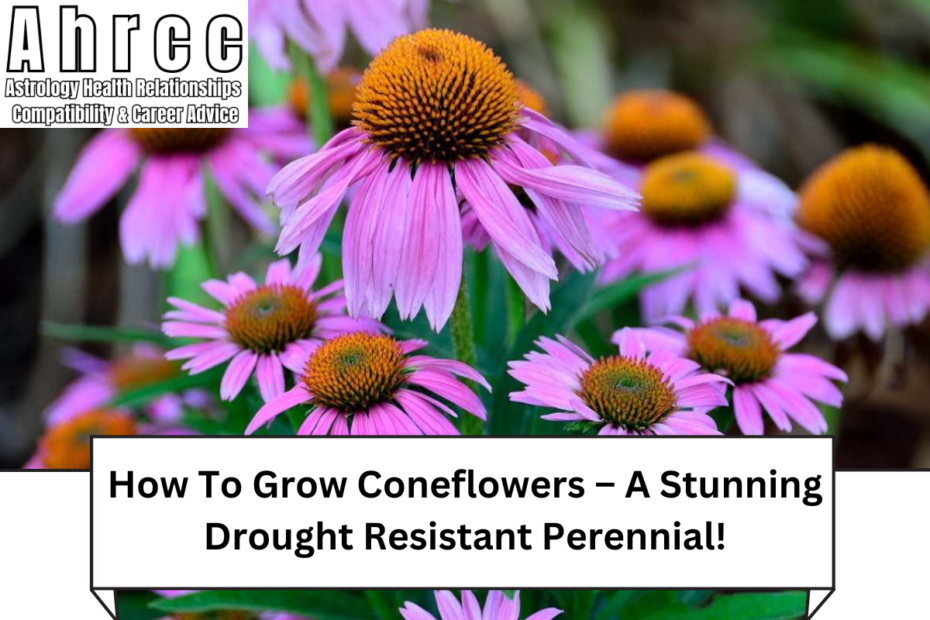How To Grow Coneflowers – A Stunning Drought Resistant Perennial!: Coneflowers (Echinacea) are hardy, drought-resistant perennials known for their stunning, daisy-like blooms and cone-shaped centers.
Native to North America, these flowers are prized not only for their beauty but also for their ability to thrive in hot, dry conditions. Coneflowers are low-maintenance, attract pollinators like bees and butterflies, and are resistant to many pests and diseases.
Whether you’re new to gardening or a seasoned pro, coneflowers are an excellent addition to any landscape, providing vibrant color from summer through fall.
Why Grow Coneflowers?
- Drought-Resistant: Once established, coneflowers are highly drought-tolerant, making them ideal for gardens in hot and dry climates.
- Attract Pollinators: Coneflowers are a magnet for pollinators, including bees, butterflies, and hummingbirds.
- Long Blooming Season: These perennials bloom from early summer through fall, providing long-lasting color in the garden.
- Low Maintenance: They require minimal care, are disease-resistant, and thrive in various soil types.
- Medicinal Properties: Echinacea, derived from coneflowers, is used in herbal remedies to boost the immune system and combat colds.
Step-by-Step Guide to Growing Coneflowers
1. Choosing the Right Coneflower Variety
Coneflowers come in several varieties, ranging from the classic purple Echinacea purpurea to newer hybrids in shades of pink, yellow, white, and orange. Here are some popular varieties:
- Echinacea purpurea: The traditional purple coneflower with a dark orange-brown cone.
- Echinacea pallida: Pale purple petals that droop gracefully.
- Echinacea paradoxa: The rare yellow coneflower, providing a bright contrast to other garden plants.
- Echinacea ‘Cheyenne Spirit’: A colorful mix of shades, including orange, red, and cream.
Choose a variety based on your garden design and the height you desire. Coneflowers can range from 2 to 5 feet tall.
2. Planting Coneflowers
When to Plant: Plant coneflowers in the spring or early fall. These hardy perennials need time to establish roots before the extreme heat or cold sets in.
Location: Coneflowers thrive in full sun, requiring at least 6 hours of sunlight daily. They can tolerate partial shade but may produce fewer blooms.
Soil: Although coneflowers can grow in a variety of soils, they prefer well-draining, slightly acidic to neutral soil (pH 6.0-7.0). If your soil is heavy clay or very sandy, amend it with compost to improve drainage and nutrient content.
3. Planting from Seeds or Transplants
Direct Sowing Seeds: If starting from seeds, you can directly sow them in the garden after the danger of frost has passed. Lightly press the seeds into the soil without covering them, as they need sunlight to germinate. Keep the soil moist until the seeds germinate, which usually takes 10-20 days.
Transplanting: If using nursery-grown plants or seedlings started indoors, space the plants 12-24 inches apart, depending on the variety. Plant them at the same depth as they were in their containers and water thoroughly.
4. Watering and Mulching
Coneflowers are drought-tolerant once established but require regular watering during their first growing season. Water deeply once a week, allowing the soil to dry out between waterings. After the plants are established, they can tolerate dry conditions, making them ideal for xeriscaping.
Mulching around the base of the plants helps conserve moisture and keeps the roots cool. Use organic mulch, such as wood chips or straw, to reduce weed competition and improve soil quality.
5. Fertilizing
Coneflowers do not need heavy fertilization. In fact, too much fertilizer can lead to fewer blooms and weaker stems. If your soil is poor, you can apply a balanced, slow-release fertilizer in the spring. Alternatively, a yearly application of compost around the plants will provide sufficient nutrients.
6. Deadheading and Pruning
Deadheading coneflowers, or removing spent blooms, encourages the plant to produce more flowers throughout the season. Cut back the flower stems just above a leaf node to promote new growth. However, if you prefer to leave the seed heads intact, they can add winter interest to the garden and provide food for birds, especially goldfinches.
In late fall or early winter, cut back the stems to ground level once the plants have died back. This helps maintain a tidy garden and reduces the chances of overwintering pests.
7. Pests and Diseases
Coneflowers are generally resistant to pests and diseases, but they can occasionally be affected by aphids, leafhoppers, or powdery mildew. To prevent these issues, ensure good air circulation by spacing plants properly and avoid overhead watering. If necessary, treat infestations with insecticidal soap or neem oil.
Growing Coneflowers in Containers
Coneflowers can also be grown in containers, especially smaller or dwarf varieties. Choose a container with good drainage holes and fill it with a well-draining potting mix.
Water container-grown coneflowers more frequently, as containers dry out faster than garden soil. Place the container in a sunny spot, and deadhead regularly to encourage continuous blooming.
Propagating Coneflowers
Coneflowers can be propagated through division or seeds. To divide, dig up the plants in early spring or fall and gently separate the root clumps before replanting them. This helps refresh older plants and ensures vigorous growth.
If you want to collect seeds, allow the flowers to dry on the plant and harvest the seed heads. Store the seeds in a cool, dry place until you’re ready to plant them.
Conclusion
Coneflowers are stunning, low-maintenance perennials that add vibrant color and texture to any garden. Their drought resistance, long blooming season, and ability to attract pollinators make them a favorite among gardeners looking for an easy-care plant.
Whether planted in beds, borders, or containers, coneflowers will thrive with minimal attention and reward you with beautiful blooms year after year. By following these simple growing tips, you can enjoy the beauty of coneflowers while reducing your garden’s water needs.
